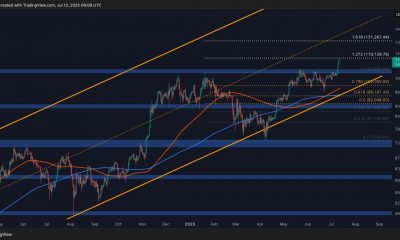Economy
Largest European energy companies threatened with $1.5 trillion margin call

Governments of EU countries will have to help the largest European energy companies, many of which are on the verge of bankruptcy because of the sharp decline in liquidity.
European energy companies may get a margin call. Europe is now facing a new crisis similar to that which brought about the collapse of the American bank Lehman Brothers 14 years ago and triggered the global financial crisis. Only the culprits of the European financial crisis will not be banks, but energy companies. European energy companies are rapidly losing liquidity. As a result, they’re threatened by a $1.5 trillion margin call on the derivatives market, Bloomberg reported. Many energy companies will need financial assistance from governments. There’s no doubt they’ll get it, because no politician in his right mind would want to get energy companies bankrupt on the eve or in the middle of a tough winter.
Some European countries decided not to wait for the crisis and announced bailout programs for their energy companies to prevent a margin call for European energy companies. Last weekend, the governments of Finland and Sweden became pioneers in saving energy companies. They intend to support Finnish and Swedish energy companies trading on energy derivatives markets.
The crisis intensified on September 2 when Gazprom announced that it was shutting off the Nord Stream 1 gas pipeline for an indefinite period and attributed the decision to an oil leak in the only working turbine at the Portovaya gas station. Moscow said European sanctions against Russia were to blame for the shutdown, while Brussels and Berlin once again accused Moscow of using energy as a weapon and called Gazprom an unreliable partner.
A Finnish government statement said that Helsinki’s proposed bailout scheme is a last-ditch effort to avoid bankruptcy of energy companies. The Finnish Finance Ministry is expected to open a credit line of 10 billion euros for energy companies.
The Swedish government will offer loan guarantees to large electricity producers in the kingdom trading in the energy derivatives market. The total amount of collateral in the market almost tripled over the summer, from 70 billion Swedish kronor (about $6.5 billion) to 180 billion kronor, according to the government.
“The aim of these measures is to prevent a sharp decline in liquidity that threatens to spread to other areas of the financial system,” the Swedish Finance Ministry said in a statement.
It’s not just commodity markets that are facing economic problems today. Meta financial stock fell 19% in the fall as the world’s largest social media platform joined other big tech groups in warning that the economic downturn was hitting its advertising business as brands spent less on marketing. In addition to broader macroeconomic challenges, Meta faces a host of others, including growing competition for Instagram from TikTok and difficulty targeting and measuring ads due to changes in Apple’s privacy policy.
We previously reported that China’s Liquefied Natural Gas Companies Increase LNG Sales to Europe.
Economy
Russian central bank says it needs months to make sure CPI falling before rate cuts -RBC


© Reuters. Russian Central Bank Governor Elvira Nabiullina attends a news conference in Moscow, Russia June 14, 2019. REUTERS/Shamil Zhumatov/File Photo
MOSCOW (Reuters) – Russia’s central bank will need two to three months to make sure that inflation is steadily declining before taking any decision on interest rate cuts, the bank’s governor Elvira Nabiullina told RBC media on Sunday.
The central bank raised its key interest rate by 100 basis points to 16% earlier in December, hiking for the fifth consecutive meeting in response to stubborn inflation, and suggested that its tightening cycle was nearly over.
Nabiullina said it was not yet clear when exactly the regulator would start cutting rates, however.
“We really need to make sure that inflation is steadily decreasing, that these are not one-off factors that can affect the rate of price growth in a particular month,” she said.
Nabiullina said the bank was taking into account a wide range of indicators but primarily those that “characterize the stability of inflation”.
“This will take two or three months or more – it depends on how much the wide range of indicators that characterize sustainable inflation declines,” she said.
The bank will next convene to set its benchmark rate on Feb. 16.
The governor also said the bank should have started monetary policy tightening earlier than in July, when it embarked on the rate-hiking cycle.
Economy
China identifies second set of projects in $140 billion spending plan


© Reuters. FILE PHOTO: Workers walk past an under-construction area with completed office towers in the background, in Shenzhen’s Qianhai new district, Guangdong province, China August 25, 2023. REUTERS/David Kirton/File Photo
SHANGHAI (Reuters) – China’s top planning body said on Saturday it had identified a second batch of public investment projects, including flood control and disaster relief programmes, under a bond issuance and investment plan announced in October to boost the economy.
With the latest tranche, China has now earmarked more than 800 billion yuan of its 1 trillion yuan ($140 billion) in additional government bond issuance in the fourth quarter, as it focuses on fiscal steps to shore up the flagging economy.
The National Development and Reform Commission (NDRC) said in a statement on Saturday it had identified 9,600 projects with planned investment of more than 560 billion yuan.
China’s economy, the world’s second largest, is struggling to regain its footing post-COVID-19 as policymakers grapple with tepid consumer demand, weak exports, falling foreign investment and a deepening real estate crisis.
The 1 trillion yuan in additional bond issuance will widen China’s 2023 budget deficit ratio to around 3.8 percent from 3 percent, the state-run Xinhua news agency has said.
“Construction of the projects will improve China’s flood control system, emergency response mechanism and disaster relief capabilities, and better protect people’s lives and property, so it is very significant,” the NDRC said.
The agency said it will coordinate with other government bodies to make sure that funds are allocated speedily for investment and that high standards of quality are maintained in project construction.
($1 = 7.1315 renminbi)
Economy
Russian central bank says it needs months to make sure CPI falling before rate cuts -RBC


© Reuters. Russian Central Bank Governor Elvira Nabiullina attends a news conference in Moscow, Russia June 14, 2019. REUTERS/Shamil Zhumatov/File Photo
MOSCOW (Reuters) – Russia’s central bank will need two to three months to make sure that inflation is steadily declining before taking any decision on interest rate cuts, the bank’s governor Elvira Nabiullina told RBC media on Sunday.
The central bank raised its key interest rate by 100 basis points to 16% earlier in December, hiking for the fifth consecutive meeting in response to stubborn inflation, and suggested that its tightening cycle was nearly over.
Nabiullina said it was not yet clear when exactly the regulator would start cutting rates, however.
“We really need to make sure that inflation is steadily decreasing, that these are not one-off factors that can affect the rate of price growth in a particular month,” she said.
Nabiullina said the bank was taking into account a wide range of indicators but primarily those that “characterize the stability of inflation”.
“This will take two or three months or more – it depends on how much the wide range of indicators that characterize sustainable inflation declines,” she said.
The bank will next convene to set its benchmark rate on Feb. 16.
The governor also said the bank should have started monetary policy tightening earlier than in July, when it embarked on the rate-hiking cycle.

 Forex3 years ago
Forex3 years agoForex Today: the dollar is gaining strength amid gloomy sentiment at the start of the Fed’s week

 Forex3 years ago
Forex3 years agoUnbiased review of Pocket Option broker

 Forex3 years ago
Forex3 years agoDollar to pound sterling exchange rate today: Pound plummeted to its lowest since 1985

 Forex3 years ago
Forex3 years agoHow is the Australian dollar doing today?

 Cryptocurrency3 years ago
Cryptocurrency3 years agoWhat happened in the crypto market – current events today

 World3 years ago
World3 years agoWhy are modern video games an art form?

 Commodities3 years ago
Commodities3 years agoCopper continues to fall in price on expectations of lower demand in China

 Economy3 years ago
Economy3 years agoCrude oil tankers double in price due to EU anti-Russian sanctions



























